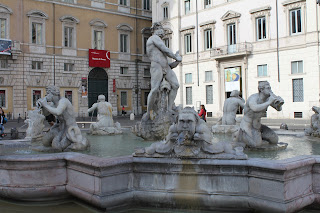 |
| We start things off right by enjoying some of that wonderful Italian gelato at a stand at the top of the Spanish Steps. Bev's choice: pistachio, of course. |
 |
| The Spanish Steps, with Trinita dei Monti at the top. This is a relatively thin crowd as we were not there during the high season. |
 |
| The Keats-Shelley Memorial House at the bottom of the steps, where John Keats died in 1821. |
 |
The house is now a museum honoring English Romantic poets. |
 |
| View from the top of the steps: the farthest dome on the horizon is that of St. Peter's. |
 |
| Interior of the 16th Century Trinita dei Monti. |
 |
| Cafe Greco on the Via Condotti, just off the Piazza di Spagna, a meeting place for writers and musicians since the 18th Century. |
 |
| Photo of a gathering of of literary lights of a bygone era at the Greco. |
 |
| We tried some roasted chestnuts out of curiosity since Hemingway mentioned them in one or more places. Our verdict: much like warm soggy wood. |
 |
| Papal coat of arms crowning the Trevi Fountain - reminders of the centuries of the worldly power of the popes are everywhere in Rome. |
 |
| Tourists at the Trevi. |
 |
| Neptune presides over his realm - a trivia question: what is the name of the Roman girl in the second story relief showing the spring to parched soldiers? Answer: Trivia. |
 |
 |
| Some cafes on the Veneto still boast of the celebrities they have hosted over the years. |
 |
The entire city is really a museum and we tried to remember to look up: plaque on the Via del Corso commemorating a building where Shelley wrote. |
 |
| The entire column is covered with reliefs commemorating Roman victories over the "barbarians." |
 |
| Colosseum by night |
 |
| St. Peter's |
 |
| Morning in the Piazza Navona, a magnificent Baroque environment featuring no less than three important fountains and a huge obelisk, this one topped with a dove bearing an olive branch. |
 |
| Fontana del Moro, at the southern end of the piazza. |
 |
| The Nile conceals his face, for the source of that great river was not yet known in the 17th Century. Sant' Agnese in Agone is behind the fountain. |
 |
| Artists setting up their easels and displays in the morning light. |
 |
| Fountain of Neptune at the northern end. |
 |
| Add caption |
 |
| The Pantheon is the most intact of the ancient Roman structures and its colossal dome, here hidden by the portico, is a wonder to behold. |
 |
| The venerable temple has been a Christian church since the 7th Century. |
 |
| The oculus provides the only source of light. |
 |
| The lavishly appointed Sant' Ignazio di Loyola is perhaps the boldest architectural statement of the Counter-Reformation. |
 |
| The trompe l'oeil, or illusionistic, ceiling invites the viewer to gaze up into a portal to Heaven opened by the missionary efforts of the Jesuits. |
 |
| Saint Ignatius Loyola, founder of the Society of Jesus. |
 |
 |
| Bev tries to decide which of the inviting pastries to sample. |
 |
| Colosseum |
 |
| The magnificence of this structure was tempered somewhat for me by the thought of all the people and animals who suffered here to provide entertainment for the Roman masses. |
 |
| Arch of Constantine. |
 |
| And then the Forum, with all the thoughts of the glory of ancient Rome followed by its decline and fall. |
 |
| Arch of Septimius Severus, with one of the chariots of the Victor Emmanuel Monument visible above it. |
 |
| Temple of Antoninus and Faustina, now a part of San Lorenzo in Miranda. |
 |
| Arch of Titus |
 |
| Relief on the interior of the arch commemorating the destruction of Jerusalem in AD 70. The great menorah from the temple is clearly visible. |
 |
| Dome of St. Peter's, designed by Michelangelo. |
 |
| Roman mosaic in the Vatican Museums. |
 |
| Roman statue of Hercules. |
 |
| Diana prepares to draw an arrow from her quiver while her faithful companion stands alert by her side. |
 |
| Domine, Quo Vadis? Then we visited the Sistine Chapel where no photos or talking is allowed. There are monitors there whose only function seems to be to hiss at whisperers. - strange job description. |
 |
| Filarete Doors at St. Peter's depicting St. Paul and St. Peter. |
 |
| Interior of St. Peter's. |
 |
| Michelangelo's Pieta |
 |
| Monument to Pope Gregory XIII |
 |
| Tomb of Pope John XXIII, the great 20th Century reformer. |
 |
| 13th Century statue of St. Peter. His foot is worn thin by pilgrims touching it over the centuries while asking a blessing - I did my part. |
 |
| Bernini's 17th Century Baldacchino |
 |
| Interior of the 448 foot dome |
 |
| St. Helena |
 |
| St. Veronica |
 |
| Bernini's monument to Pope Alexander VII |
 |
| Monument to St. John Baptist De La Salle, namesake of my alma mater. |
 |
| Exterior of St. Peter's with the piazza being prepared for a papal audience the next day. |















